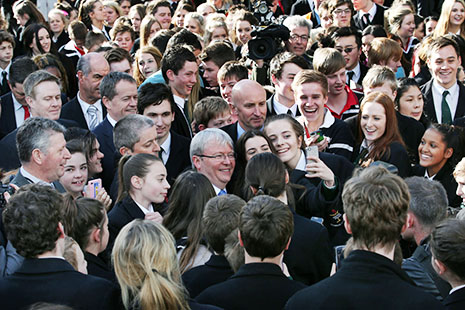GONSKI’s survival to this point and its reluctant endorsement by the federal opposition represent a considerable political achievement on the part of the government, and of Julia Gillard in particular, against many expectations and predictions, including mine.
There is much to be grateful for in this win, particularly if we remember the disreputable scheme that awaited defeat. Against the status quo, Gonski proposed that schools doing the most difficult educational work should get more money to help them do it better; that this rule should apply in a common way to any such school, government, Catholic systemic or independent, in every state and territory; and that by these means “residualisation,” the steady drift of “good” students to “good” schools at the expense of “disadvantaged” ones, might be reduced.
Gonski has come to symbolise a sense of social decency (honourably defended, it should be noted, by a conservative NSW government in the persons of education minister Adrian Piccoli and premier Barry O’Farrell). It advances the important principle that all schools, government and non-government alike, must serve public purposes. If implemented, Gonski will cheer up those working in and dependent on the most disadvantaged schools (most of them government schools), and perhaps the government sector in general.
All this granted, it must still be said that Gonski has become the bearer of hopes and fears out of all proportion to its practical import. That it has attracted such passions of support and opposition and has consumed so much of the political oxygen available to education over several years suggests that there is something wrong with both the conduct of Australian schooling and our capacity to imagine its future.
GONSKI had important things to say about the distribution of resources, but little about where they should come from, or about their use. In the Gonski scheme the money still comes from both state and federal governments and (for non-government schools) from parents. It blurs the boundaries of the sector system, but leaves intact different forms of governance and regulation as well as divisions between “fee and free,” secular and religious. Rules and practices that allow student “creaming” and exclusion are unchallenged. Funding floors are proposed, but not funding ceilings.
As to use, Gonski endorsed the “effective schools” approach to getting value for money, but was unable to require or enforce it. It is true that Gonski proposed a new “schools resourcing body,” but that too was a relatively modest proposal, for a national (not federal government) agency not all that different from other bodies that operate now or have done in the past. Even in matters of distribution Gonski was bold without being revolutionary. The basic distributional principle of “need” has long been supported in various ways and degrees in most school jurisdictions.
In short, the passions surrounding Gonski have more to do with its threat to change power over schooling rather than schooling itself. For just that reason we must wonder whether it will make a significant difference to those on whom Gonski rightly focuses attention, and particularly to the half a million or so students in the system at any one time who will leave school lacking even the minimal literacy and numeracy needed to get and hold down a job, mostly the sons and daughters of poor, Indigenous, remote, and non-English-speaking families.
Any answer is complicated by the fact that the Rudd and Gillard governments have introduced other changes, ranging from infrastructure and equipment upgrades through teacher education to the collection and publication of information about the income and performance of every school in the country. Encouraged by national and international comparisons of “student performance,” the mood in all sectors and systems is to home in on, measure and lift outcomes in key areas of learning. As well, recently installed Coalition governments in the four most populous states have introduced reforms of their own devising, in one case (New South Wales) in explicit support of Gonski, in others not. Catholic systems and other non-government schools have their own reform programs too. Prediction is further complicated by the ecological character of school systems. The effects of change are almost as hard to anticipate as they are to control.
But, with bets thus hedged, my guess is that if there is any improvement it will be slower and patchier than in a number of other OECD systems.
For one thing, “Gonski” now is not what Gonski proposed. The national schools resourcing body was soon ditched. So was Gonski’s recommendation that the new needs-based loadings be confined to just one in four schools; the money is now proposed to be spread much more thinly. Gonski’s common national funding formula has been replaced by assurances that each “jurisdiction” will be free to determine its own way of turning principle into practice.
If, as seems likely, Gonski’s career from this point depends on an Abbott government, further attrition can be expected. The Coalition’s heart is in subsidising “choice” rather than reducing the need for it. LINK ABBOTT FEB 2012 It has said that it will drop the conditions on funding and simply hand the money over. The Coalition’s promises extend only for the period of the forward estimates, during which time funding commitments are still relatively low. Besides, any federal government of the coming period will be strapped for cash, its state and territory funding partners even more so. Anything Labor says about the later years is indicative at best.
THE sums currently promised are not as large at either aggregate or school level as is often assumed. Informed estimates suggest that funding increases under the Gonski scheme will fall below the growth trend-line of the past decade or so, and that loadings for need will attract less than one dollar in five. Whatever the exact amounts, it is clear that by the time the funds arrive in schools they will permit improvement rather than transformation of the kind persuasively advocated by Bill Hannan in his picture of “Pariah College.” It is hard to see Gonski money stemming the steady flow of “aspirational” families into schools catering to families just like them. It will not be sufficient to compensate for big differences in schools’ social, political, cultural and educational capital.
If not transformation, then improvement? Providing money to make improvement possible is not the same as making it happen. Gonski’s hopes are pinned on the “effective schools” paradigm and its focus on lifting measurable outcomes by the steady application of “what works,” particularly improved “teacher quality.”
The “effectiveness” idea is certainly a big advance on the formless “innovation” that consumed so much reforming energy in schools, and thanks to Australia’s particularly maladroit ways of deploying and developing teachers provides plenty of scope for improving “teacher effectiveness.” But there is an important caveat to the effectiveness prescription: it must be applied, as one of Gonski’s key advisers put it, in a “comprehensive, integrated and sustained” way.
That cannot happen on a national scale. The Gillard government made several attempts to install the effectiveness paradigm as the official national doctrine of school reform, most recently through the “school development plans” tacked onto Gonski. This proposal was already the subject of hot resistance from the states and sectors when the Coalition announced its intention to drop the whole idea. The current division of functions and responsibilities between federal and state governments, and between government and non-government sectors, generates so much confusion and conflict that there can be no “comprehensive, integrated and sustained” national strategy for schooling.
It may well be that there can’t be state-level strategies either. One problem is that the sector system exists in microcosm in each of the states and territories, but more important is the politicisation of schooling that accompanied the long decline of once-mighty state education departments. State-level decisions about the large-scale, long-lead-time enterprise of schooling are acutely vulnerable to short electoral cycles and hence to powerful interest groups formed around the sectors and the teaching workforce.
In short, the approach to school reform reflected in and endorsed by Gonski is probably beyond the capacities of the Australian system of governance. And it may not be the right one anyway.
BOTH Gonski and the “effective schools” prescription are refinements of an agenda formed during the overcrowding and funding crisis of the 1950s and 1960s. That agenda placed a big bet on more: more money for better-trained and qualified teachers working in much smaller classes, it assumed, would deliver more, better and more equal education for all.
On balance, it must be concluded that the bet has been lost. More students did get more years at school; the girls did catch up with and surpass the boys; and schools and classrooms did become much less forbidding and more congenial places. But in most circumstances smaller classes turned out to be more manageable and informal but no more productive than larger ones. Comparisons of “outcomes” over time, such as they are, suggest limited or no gains. The pay, standing and standards of entry to the teaching profession are much as they were, or worse. Although class sizes have tumbled by 40 per cent or more, problems of social and regional inequality, engagement and purpose persist. Gains, however calculated, have not been commensurate with costs. The best available estimate is that each student year now costs two-and-a-half times as much as it did in the early 1960s.
It seems increasingly likely that “the problem” is less one of scale than of kind, less in the level of resources than in the way they are turned into time and effort, and less in the things Gonski and the effectiveness paradigm have attended to than in what they took as given – or what might be called a mode of educational production.
Postwar reform metastasised a cottage industry. The fundamental unit of production, “the class” – one teacher in control of a fixed maximum number of students of the same age but of widely differing learning stages, speeds and styles, working in five or six forty-five-minute bursts per day on a single topic in a single subject – reproduced itself again and again as more and more students stayed longer and longer at school in ever-smaller classes. This vastly multiplied cellular organism entrenched itself in the practices and expectations of teachers, students, researchers and parents, as well as in regulations, budgets and infrastructure.
The problem with “the class” is that it organises the work of students in a way that makes it difficult for many of them to learn, and therefore makes it difficult for teachers to teach. Differences in stage, speed and style of learning are so marked, even in the early years, that only a small minority of exceptionally able teachers (“highly effective” teachers, as the effectiveness paradigm calls them) can keep most students “on task” and making progress most of the time.
Despite the endless experimentation with student grouping, assessment and curriculum thus provoked, it was until recently difficult to imagine what a better organisation of student work might look like. For this reason, “effectiveness” researchers (like just about everyone else) took “the class” as a given. Their focus was on extracting marginal improvement from “the class,” mainly by developing marginally more effective teachers.
Two revolutions, one internal to schooling, the other external, are bringing “the class” into focus, and they may have brought us to the cusp of a quite different way of organising student work. The first of these revolutions is the fruit of teacher experimentation as well as investigation by researchers (many of them former teachers). The foundational idea, given many different names, is “educability” rather than “ability,” the view that all students can learn if ways can be found to keep them in “the zone of proximal development,” working on tasks not too easy, not too hard within a “developmental continuum” that will see them moving in their own way, at or near their own maximum speed, from first days at school to a successful conclusion twelve years later.
The second revolution is in digital technologies that promise to reduce problems in management arising from the first. New and emerging combinations of hardware, software and content make it possible to “personalise” each student’s program of work and to track progress through it. In the doing, these new technologies perform some of the tasks hitherto undertaken by teachers, or hand them over to the students themselves.
One implication is that the hopes of reformers should be placed less in “teacher quality” than in the quality of the student labour process. Another is that schooling will require a different division of labour between and among students and the adults who work with them, and therefore different career and training paths and reward structures. A third is that at least as much attention must be given to redeploying resources as to quantities and shares of them. A fourth is that much of the work of the next reform agenda will lie in dismantling the legacies of the last one – its knotted combination of infrastructure, expectations and habits of mind, regulation of the daily work of students and teachers backed by industrial and political muscle, and budgets mostly consumed by the salaries of very large numbers of a single kind of education worker, “the teacher.” A last is that Gonski and the effective schools paradigm may come to seem, as Debussy is supposed to have said of Wagner, less like a new dawn than a glorious sunset. •




